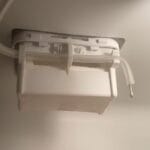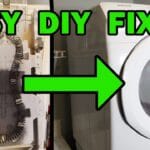Have you ever been frustrated by your dryer blowing cold air instead of the warm gusts you were expecting? You’re not alone.
This common household problem can leave you with damp clothes and a heap of unanswered questions. You might wonder if it’s something simple or a sign of a bigger issue. Understanding why your dryer is acting up can save you time, money, and a lot of stress.
Imagine swiftly solving the problem and getting your laundry back on track. That’s exactly what this article aims to help you achieve. Dive into the insights we share here, and discover the reasons behind your dryer’s chilly performance. Get ready to tackle the issue head-on and reclaim your laundry days with confidence.
Common Causes Of Cold Air In Dryers
A dryer blowing cold air might have a broken heating element, a faulty thermostat, or a clogged vent. These issues disrupt the normal heating process. Identifying the cause ensures efficient drying and prevents longer drying times. Regular maintenance can help avoid these common problems.
Are you frustrated because your dryer is blowing cold air? Don’t worry; you’re not alone. Many people face this issue and often don’t know where to start troubleshooting. By understanding the common causes of cold air in dryers, you can potentially save money and time.
Heating Element Issues
A faulty heating element is one of the most frequent culprits. This component is responsible for producing the heat that dries your clothes. If it’s broken, your dryer will blow cold air instead. You might want to check for visible signs of damage or use a multimeter to test its functionality. Have you ever wondered why a simple piece of metal can halt your laundry routine? It’s because the heating element is the heart of your dryer’s heating system.
Thermostat Malfunctions
The thermostat regulates the temperature inside your dryer. If it fails, your machine might blow cold air due to incorrect temperature readings. A malfunctioning thermostat can trick the dryer into thinking it’s hotter than it actually is. Consider replacing it if you find it faulty. Isn’t it surprising how a small device can cause so much inconvenience?
Faulty Thermal Fuse
The thermal fuse acts as a safety mechanism to prevent overheating. If it blows, the dryer will not produce heat. Unlike other components, this fuse cannot be reset; it must be replaced. Checking the thermal fuse is a straightforward task that can save you a lot of hassle. Have you checked this small yet crucial element in your machine lately?
Blocked Ventilation
Blocked ventilation can also be a reason for your dryer blowing cold air. Lint and debris can clog the vents, leading to insufficient airflow. This not only affects drying efficiency but also poses a fire hazard. Cleaning your dryer vents regularly can prevent this issue. Isn’t it amazing how something as simple as regular cleaning can avert major problems? By tackling these common issues, you’re taking the first step toward resolving your dryer’s cold air problem. Always remember, a little bit of maintenance goes a long way. Which of these causes do you suspect might be affecting your dryer?
Credit: www.tiktok.com
Diagnosing Dryer Problems
When your dryer starts blowing cold air, it’s not just frustrating; it’s a sign that something’s off. Diagnosing dryer problems can seem daunting, but breaking it down into steps makes it manageable. You don’t need to be a professional to tackle this – just a bit of patience and a keen eye.
Testing The Heating Element
Begin by checking the heating element, as it’s often the culprit when your dryer isn’t producing warm air. Unplug your dryer and locate the heating element, typically found at the back. Use a multimeter to test for continuity – if there’s no continuity, the element needs replacing.
Replacing a faulty heating element is a straightforward fix. You’ll notice an immediate difference in performance. A functioning heating element ensures your clothes dry efficiently, saving you time and energy.
Checking Thermostat Functionality
The thermostat regulates the temperature inside your dryer. If it’s faulty, your dryer may not heat correctly. Test it with a multimeter to ensure it’s working.
In my experience, a malfunctioning thermostat can cause inconsistent drying. Replacing it can restore your dryer’s performance. It’s a small component but crucial for maintaining the right temperature.
Inspecting The Thermal Fuse
A blown thermal fuse can cause your dryer to blow cold air. This safety device prevents overheating, but once it’s blown, it needs replacement. Check it with a multimeter for continuity.
Replacing a thermal fuse is a simple fix that can prevent future problems. It’s a reminder of the importance of safety features in appliances. Don’t overlook this small but mighty component.
Evaluating Ventilation Systems
Sometimes, the issue isn’t within the dryer itself but in the ventilation system. Blocked vents can cause your dryer to overheat and blow cold air as a safety measure. Check your venting system for any obstructions.
Regular maintenance of your dryer’s vents can prevent this problem. Clean them out to ensure optimal airflow. Proper ventilation is crucial for your dryer’s efficiency and longevity.
Diagnosing dryer problems may seem overwhelming at first, but these steps make it manageable. Have you ever tackled a dryer issue on your own? It’s empowering to solve these problems, and you’ll gain a deeper understanding of your appliances.
Effective Solutions For Dryer Issues
Dryer blowing cold air might indicate a faulty heating element or thermostat. Clogged vents can also cause this problem. Regular maintenance ensures efficient drying and prevents cold air issues.
When your dryer suddenly starts blowing cold air, it can be more than just a minor inconvenience. You’re left with damp clothes and the frustration of figuring out what went wrong. Fortunately, there are effective solutions to tackle these dryer issues. Whether it’s a simple fix or a part replacement, understanding the problem helps you get back to your laundry routine without hassle. Let’s delve into some practical solutions that can save you time and money.
Replacing The Heating Element
A faulty heating element is often the culprit behind cold air. It’s like trying to bake a cake with a broken oven. To check, unplug your dryer and access the element, usually found at the back. If it’s visibly damaged or broken, replacing it can restore your dryer’s warmth. Remember, a simple DIY replacement might require a bit of patience but could save you a service call.
Repairing Or Replacing The Thermostat
The thermostat regulates the dryer’s temperature. If it malfunctions, you might end up with cold air instead of the heat you need. Test the thermostat with a multimeter to check for continuity. A lack of continuity indicates it’s time for a replacement. Have you ever had an appliance act up because of a minor part? Fixing or replacing the thermostat can make a world of difference.
Changing The Thermal Fuse
A blown thermal fuse can stop your dryer from heating. It’s a safety feature designed to prevent overheating. If the fuse is blown, the dryer won’t heat at all. To fix this, locate the fuse and test it for continuity. Replacing a blown fuse is relatively straightforward and can get your dryer back to working order. Have you considered how such a small component can prevent bigger issues?
Cleaning And Clearing Vents
Clogged vents can cause your dryer to blow cold air due to restricted airflow. Lint buildup not only affects efficiency but also poses a fire hazard. Regularly clean the lint filter and check the vent hose for blockages. You might find a surprising amount of lint that’s been hiding. A thorough clean can improve performance and safety, ensuring warm air flows freely again. In tackling these issues, hands-on experience combined with a little patience can go a long way. Have you ever solved a household problem by investigating and fixing it yourself? These solutions not only extend the life of your dryer but also empower you to handle appliance hiccups with confidence.

Credit: www.youtube.com
Preventive Measures
Preventive measures play a crucial role in ensuring your dryer functions well. A dryer blowing cold air can lead to longer drying times. This can increase your energy bills. Simple preventive steps can help avoid these issues. They can extend the life of your dryer too. Regular maintenance and proper usage can prevent cold air problems.
Regular Maintenance Tips
Regular maintenance keeps your dryer running efficiently. Clean the lint filter after every use. This prevents blockages and improves airflow. Vacuum the exhaust vent every few months. This removes lint buildup and ensures proper ventilation. Check the dryer drum seals for wear and tear. Replace them if necessary to maintain heat.
Optimal Dryer Usage Practices
Using your dryer correctly can prevent cold air issues. Do not overload your dryer. Overloading affects airflow and drying efficiency. Sort clothes by fabric type and weight. This ensures even drying and prevents strain on the dryer. Use the correct heat settings for different fabrics. High heat may not be suitable for all clothes.
Signs To Watch Out For
Recognizing early signs can prevent bigger problems. If clothes take longer to dry, check the vent for blockages. Listen for unusual noises during operation. These may indicate mechanical issues. If the dryer feels cold, inspect the heater for faults. Addressing these signs early can prevent costly repairs.
Professional Help Vs Diy
Experiencing a dryer blowing cold air can be frustrating. A professional can quickly identify technical issues, ensuring safety and efficiency. DIY attempts might miss hidden problems, leading to more costs.
Dryer problems can be frustrating. One common issue is the dryer blowing cold air. Understanding whether to fix it yourself or hire a professional can save time and money. Each approach has its benefits and drawbacks. Weighing these options helps make the right decision.
When To Hire A Technician
Hiring a technician can be the best choice. Complex electrical issues require expert skills. Professionals have the right tools. They diagnose problems quickly. Safety is another concern. Handling electricity without training is risky. If the dryer is under warranty, repairs might be free. Technicians ensure the job is done right. This provides peace of mind.
Diy Repair Considerations
DIY repair can be rewarding. Start with simple checks. Ensure the dryer is plugged in. Check the circuit breaker. Clean the lint filter. These fixes are easy. Consult the user manual. It provides troubleshooting tips. Online tutorials can guide repairs. DIY saves on labor costs. But be cautious. Incorrect repairs can worsen the problem. Safety should always come first.
Cost Comparison
Cost plays a big role in decision-making. Hiring a technician can be expensive. Prices vary by location and issue complexity. DIY repairs have lower upfront costs. You spend only on parts needed. But consider potential risks. Incorrect DIY fixes can lead to costly damage. Weigh the pros and cons. Choose the option that balances cost and safety.

Credit: www.amazon.com
Frequently Asked Questions
Why Is My Dryer Not Heating Up?
Your dryer might not heat due to a tripped circuit breaker. Check and reset it.
Can A Clogged Vent Cause Cold Air In Dryer?
Yes, a clogged vent restricts airflow, causing the dryer to blow cold air. Clean it regularly.
What Role Does The Thermostat Play In A Dryer?
The thermostat regulates temperature. If faulty, it might cause your dryer to blow cold air.
How Does A Broken Heating Element Affect The Dryer?
A broken heating element means no heat production. This results in the dryer blowing cold air.
Is There A Way To Fix A Dryer Blowing Cold Air?
Check the power source, thermostat, and heating element. Replace or repair faulty parts.
Conclusion
Understanding why your dryer blows cold air is crucial. It keeps clothes clean and soft. Regular maintenance prevents issues from arising. Clean filters and vents often. Check for faulty parts. Replace them if needed. Seek professional help for complex problems.
Avoid DIY repairs that could worsen damage. With these tips, your dryer can work effectively again. Save time and energy with a fully functional appliance. Enjoy warm, dry clothes every time. Remember, a dryer in good condition is a household necessity.
Keep yours running smoothly with proper care.




